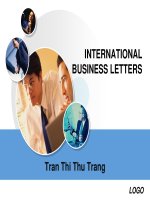TIẾNG ANH KINH TẾ International trade ESP2 unit 1
Bạn đang xem bản rút gọn của tài liệu. Xem và tải ngay bản đầy đủ của tài liệu tại đây (43.52 KB, 26 trang )
International Trade
I. Overview of International trade
1. International trade: Purchase, sale, or
exchange of goods and services across
national borders.
2. Foreign Direct Investment (FDI): Purchase of
physical assets or a significant amount of the
ownership of a company in another country to
gain a measure of management control.
3. Portfolio Investment: Investment that does not
involve obtaining a degree of control in a
company.
II. Benefits of International trade
• Open doors to new entrepreneurial opportunity across
nations.
• Provide a country’s people with greater choice of goods
and services.
• An important engine for job creation in many countries.
III. Theories of International trade
1.Mercantilism: Trade theory holding that nations should
accumulate financial wealth, usually in the form of gold,
by encouraging exports and discouraging imports.
2. Absolute advantage: Ability of a nation to produce a good
more efficiently than any other nation.
3. Comparative advantage: Inability of a nation to
produce a good more efficiently than other
nations, but an ability to produce that good more
efficiently than it does any other good.
4. Factor proportions theory: Trade theory holding
that countries produce and export goods that
require resources (factors) that are abundant
and import goods that require resources in short
supply.
IV. The balance of trade
• Visible trade consists of all those goods which
can be seen and touched such as machines,
televisions, motorcycles, refrigerators, food, raw
materials…
• Invisible trade refers to all those items which we
export, which cannot be seen or touched such
as sales of insurance, banking services, airline
seats or sea cargo space….
• The balance of trade is the difference in value
between imports and exports of goods over a
particular period.
V. The balance of payments
• The balance of payments is the difference between the
amount of money one country pays to other countries,
especially for imports, and the amount it receives,
especially for exports.
1. Current account
• Current account is a national account that
records transactions involving the import and
export of goods and services, income receipts
on assets abroad, and income payments on
foreign assets inside the country
• Current account surplus (a trade surplus): When
a country exports more goods, services, and
income than it imports.
• Current account deficit (a trade deficit): When a
country imports more goods, services and
income than it exports.
2. Capital account
• Capital account: A national account that records
transactions involving the purchase or sale of assets
VI. Exporting
1.
Export procedures
-Transport the goods to the docks or airport
-Pass them through customs
-Clear them through another set of customs on arrival
-Present them to the correct customers
2. Export documents
-Bill of lading (BL): containing details of the goods being
shipped, their destination and which ship they will be
traveling.
-Export invoice: The ‘bill’ to the customer, requiring
payment once he has received the goods.
-Certificate of origin: To prove the goods have come from
UK for example and are not being imported under false
pretences from a different country whose goods might be
prohibited from entry.
-Certificate of value: To prove the goods are worth what the
invoice says they are worth.
-Customs declaration: A signed statement of what the
parcels, packages or crates contain.
2. Export documents
-Declaration of dangerous goods: Required by
international law for certain classes of goods
such as explosives or volatile chemicals.
-Certificate of insurance: Needed by the shipping
company, or airline, or by your customer, so that
they can be assured that the value of the goods
is covered should an accident happen.
-Health certificate: Needed for drugs and similar
products and for transport of animals.
-Import licence: Permission to import your goods.
Needed for certain countries and products.
VII. Reasons for governmental
intervention in trade
• Cultural motives
-The cultures of countries are slowly altered by exposure to
the people and products of other cultures.
-Cultural influence of the United States: the United States,
more than any other nations, is seen as a threat to
national cultures around the world.
Reasons…
2.Political motives
-To protect jobs
-To preserve national security
-To respond to ‘unfair’ trade
-To gain influence
Reasons…
3. Economic motives
-To protect infant industries
-To pursue strategic trade policy
VIII. Methods of restricting trade
1.
Tariffs: Government tax levied on a product as it enters
or leaves a country.
-To protect domestic producers
-To generate revenue
2. Quotas: Restriction on the amount (measured in
units or weight) of a good that can enter or leave
a country during a certain period of time.
-Reasons for import quotas:
+To protect domestic producers by placing a limit
on the amount of goods allowed to enter the
country.
+To force companies of other nations to compete
against one another for the limited amount of
imports allowed.
-Reasons for export quotas:
+To maintain adequate supplies of a product in the home
market.
+To restrict supply on world markets, thereby increasing the
international price of the good.
3. Embargoes: Complete ban on trade (imports and
exports) in one or more products with a particular
country.
4. Local content requirements: Laws stipulating that a
specified amount of a good or service be supplied by
producers in the domestic market.
5. Administrative delays: Regulatory control or bureaucratic
rules designed to impair the rapid flow of imports into a
country.
6. Currency controls: Restrictions on the convertibility of a
currency into other currencies
IX. Organizations in international
trade
1. The International Monetary Fund (IMF)- set up in 1974 to
ensure that the world’s currencies were kept at
reasonably stable rates against each other.
2. The United nations Conference on Trade and
Development (UNCTAD) - set up in the mid-1960s, has
interests in many areas regarding international trade. It is
concerned with:
-Transport by sea and the charges which shipping
companies levy.
-the activities of multinational companies; those giant
companies which have factories making products in
many different countries (e.g. Ford, General Motor,
IBM…)
-how barriers to trade work and, especially, how they work
to the disadvantage of the poorer countries of the world.
-setting up systems to protect the prices of certain
commodities (copper, tin, tea, sugar…) which are
particularly important to the economies of the world’s
poorer countries
3. The General Agreement on tariffs and trade (GATT) – set
up after World War II with the object of reducing the
average levels of tariffs on manufactured goods
throughout the world.
4. World Trade Organization (WTO) - created on
January 1, 1995 – the only international
organization regulating trade between nations.
-Main goals:
+to help the free of trade
+to help negotiate further opening of markets
+to settle trade disputes between its members
Questions to answer
1.
2.
3.
4.
What is the difference between the balance of trade
and balance of payment?
Name three items of invisible trade.
Outline three ways in which businesses benefit from
international trade.
Why might the Vietnamese government urge the
Vietnamese consumers to “Buy Vietnamese”?









